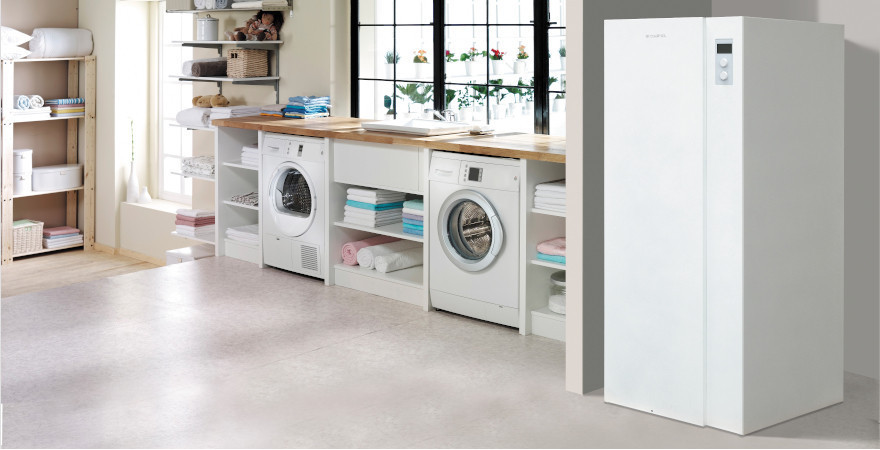
Innovation and Efficiency: KOSPEL Heat Pump 3in1 Internal Unit
In today's world, the pursuit of reducing greenhouse gas emissions and utilizing renewable energy sources has become a priority for societies worldwide. In this context, heat pump technology plays a crucial role in providing efficient and environmentally friendly heating and cooling for buildings. One interesting solution in this field is the use of a heat pump system with an internal unit, which combines elements of a hydraulic module with an electric heating element, domestic hot water (DHW) cylinder, and central heating buffer. Responding to the expectations of future heat pump users, KOSPEL has introduced such a solution.
Air-to-Water Heat Pump: Principles and Benefits
An air-to-water heat pump is an innovative device that harnesses the thermal energy present in the outdoor air for heating purposes and producing domestic hot water. It operates on the principle of the reverse refrigeration process, where thermal energy is extracted from a low-temperature source (outdoor air) and raised to the required level for efficient building heating.
KOSPEL's HPM2 heat pumps are available in various power variants, ranging from 8 kW to 23 kW (A7/W35). This versatility makes them an ideal solution for buildings with varying thermal energy requirements.
Thanks to the diversity of devices produced by KOSPEL, heat pumps can be purchased as integrated systems with dedicated components, such as the internal unit HPMI2 with a control panel, electric heating assembly, hydraulic group, SWVPC tank containing a DHW cylinder and central heating buffer tank.
Introducing HPM2.C Heating Systems with an Advanced 3-in-1 Internal Unit
To further save space and enhance user convenience, KOSPEL has created an all-in-one internal unit, which is available in the HPM2.C heat pump system.
.jpg)
Role of the KOSPEL 3-in-1 Internal Unit
An advanced central heating unit is specifically designed for HPM2.C systems with the external unit HPMO2. It features a control panel with an intuitive interface for adjusting the pump's operation settings. The unit includes essential additional devices for the correct operation of the heating system, such as an electric heating assembly, circulation pump, three-way mixing valve and safety valve, as well as a dirt separator. Furthermore, it is equipped with a DHW cylinder with a total capacity of 250 liters, ensuring hot water supply even for a household of five. The HPMD central heating unit also has a buffer tank, and the total capacity of the heating system in the unit is 81 liters. The buffer tank ensures smooth operation of the heat pump and assists in the defrosting process.

Advantages of KOSPEL's Central Heating Unit
The 3-in-1 internal unit combines the functions of a hydraulic module with a heat pump controller, DHW cylinder and central heating buffer.
Intelligent Control: An advanced control system allows for monitoring and adjusting the device's operation, providing users with complete control over the system to customize it to their individual needs.
Versatility: The internal unit can be used in various types of buildings and HPM2 heating system configurations, making it a versatile solution for diverse user requirements. It can also work in conjunction with other heat sources, such as a gas boiler.
Functionality: The unit ensures convenient and intuitive control of the heat pump. It heats domestic hot water and ensures smooth heat pump operation, including defrosting, through the buffer tank.
It's worth noting that the DHW cylinder is equipped with an electronic anode, often referred to as "titanium," which does not require periodic replacement, unlike a magnesium anode. Additionally, the buffer tank has a partition to prevent the mixing of hot and cold water in the buffer.
KOSPEL's HPM2.C system is an example of innovative technology that combines the advantages of air-to-water heat pumps with the efficiency of an advanced central heating unit. This comprehensive solution allows for the efficient and environmentally friendly utilization of thermal energy from outdoor air for heating and producing hot water. The introduction of such advanced devices into the heating industry represents a significant step toward achieving a sustainable energy future.
- Heat Pump with HPMD 3in1 Internal Unit: Heating Efficiency in a New Light
- Select a configured heat pump-based heating system
- KOSPEL cylinders and buffer tanks. The best choice for cooperation with a heat pump.
- Several different ways to get hot water. Check which one is right for you.
- Energy-saving water heating at home
- Innovation and Efficiency: KOSPEL Heat Pump 3in1 Internal Unit
- Heat Pump with HPMD 3in1 Internal Unit: Heating Efficiency in a New Light
- Several different ways to get hot water. Check which one is right for you.
- KOSPEL cylinders and buffer tanks. The best choice for cooperation with a heat pump.
- Power selection of instantaneous water heaters
 English
English 







